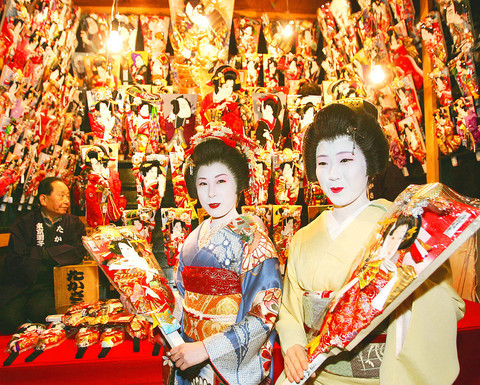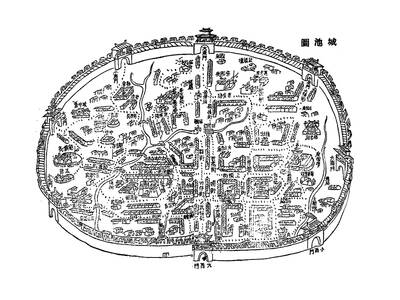The film Memoirs of a Geisha, which opens in Taiwan Jan. 13, tells the story of a poor Japanese girl who goes to work as a servant in a geisha house and ends up learning the art of the geisha.
But Sony Pictures Entertainment, parent company of Columbia Pictures, has already mastered the art of the sell, inking licensing agreements with a handful of retailers and manufacturers for merchandise tie-ins with the film.
Japanese-inspired products range from makeup to tea -- and even include leather goods, such as shoes and bags from Icon and a high-end cherry-blossom candle from the DL and Co that's available at Barneys New York.

PHOTOS: AP
"Lots of these products bubble to the surface after people see the movie," said Amy Klaris, a branding specialist at
consulting firm Kurt Salmon Associates. "The geisha look will bring a bit of the Asian touch, through higher neckline [mandarin collar] tops, beading and embroidery."
For fashionistas, that may be a welcome change of pace. Japanese-inspired fashion is a stark contrast to bohemian-chic styles that are now in vogue, featuring earth tones, flowing skirts and chunky beads.

"Asia is already in focus as an alternative ethnic inspiration to follow tired old boho," David Wolfe, a trend analyst with the Doneger Group in New York, said via e-mail.
Retailer Banana Republic has created a limited-edition holiday collection called East meets West that is priced between US$38 and US$178. The collection includes a kimono, obi-style dresses, and a quilted bag with tassel accent in rich colors of purple, navy, deep red and black.
"We played up the sexiness and glamour of both our brand and the movie, using sensual materials like silk and velvet," said Deborah Lloyd, executive vice president of design for the specialty store.
And cosmetics, which are key to attaining the look of a geisha, make natural product tie-ins.
"The beauty of the film is really the beauty," said Tom Julian, retail trends analyst. "Zhang Ziyi 's character going from girl to geisha was an art form, a skill. It was a process between fashion and makeup."
Fresh, the cosmetic firm that first introduced a sake bath and rice collection in 2000, added the Memoirs of a Geisha collection to its line in September (US$18.50-US$125; www.fresh.com). It includes an eau de parfum, a rice face wash and a flower petal mask -- each packaged in cherry blossom-designed boxes -- inspired by a kimono worn by Sayuri, Zhang's character in the film.
"The collection reflects the culture of a geisha beauty ritual," said Fresh co-founder Alina Roytberg. "It starts with a sake bath, then a rice face wash, followed by a flower petal face mask for rejuvenating the skin. The next step is applying the shimmer on eyes, lips and cheeks, followed by a lip gloss. Finally, you spray on the fragrance, a blend of white peach, rose absolute and jasmine."
"The scent is understated, just like the culture of the geisha," Roytberg said.
So far, the two biggest stars in the collection have been the perfume and the rose face palette: a satin luster cream, blush and gloss, all applied by fingertips -- the way a geisha would do it.
But the promotional tie-ins do not end with fashion and beauty. Tea also is an important part of the geisha experience and the film.
When Arthur Golden's book, Memoirs of a Geisha came out in 1997, the Republic of Tea marked the occasion with a special spring cherry green tea blend for the Barnes and Noble bookstore chain. It has revived "The blend -- Japanese Sencha green tea blended with essence of cherries, rose petals and white tea buds -- is essentially the same," said company spokeswoman Marideth Post. "For us, it was a natural tie-in and made sense. It was done in the spirit of a geisha tea ceremony."
The container's label art is from the movie; 50 tea bags are US$10 (www.republicoftea.com).
"Women can start their own rituals at home," Roytberg said.

May 26 to June 1 When the Qing Dynasty first took control over many parts of Taiwan in 1684, it roughly continued the Kingdom of Tungning’s administrative borders (see below), setting up one prefecture and three counties. The actual area of control covered today’s Chiayi, Tainan and Kaohsiung. The administrative center was in Taiwan Prefecture, in today’s Tainan. But as Han settlement expanded and due to rebellions and other international incidents, the administrative units became more complex. By the time Taiwan became a province of the Qing in 1887, there were three prefectures, eleven counties, three subprefectures and one directly-administered prefecture, with

It’s an enormous dome of colorful glass, something between the Sistine Chapel and a Marc Chagall fresco. And yet, it’s just a subway station. Formosa Boulevard is the heart of Kaohsiung’s mass transit system. In metro terms, it’s modest: the only transfer station in a network with just two lines. But it’s a landmark nonetheless: a civic space that serves as much more than a point of transit. On a hot Sunday, the corridors and vast halls are filled with a market selling everything from second-hand clothes to toys and house decorations. It’s just one of the many events the station hosts,

Among Thailand’s Chinese Nationalist Party (KMT) villages, a certain rivalry exists between Arunothai, the largest of these villages, and Mae Salong, which is currently the most prosperous. Historically, the rivalry stems from a split in KMT military factions in the early 1960s, which divided command and opium territories after Chiang Kai-shek (蔣介石) cut off open support in 1961 due to international pressure (see part two, “The KMT opium lords of the Golden Triangle,” on May 20). But today this rivalry manifests as a different kind of split, with Arunothai leading a pro-China faction and Mae Salong staunchly aligned to Taiwan.

Two moves show Taichung Mayor Lu Shiow-yen (盧秀燕) is gunning for Chinese Nationalist Party (KMT) party chair and the 2028 presidential election. Technically, these are not yet “officially” official, but by the rules of Taiwan politics, she is now on the dance floor. Earlier this month Lu confirmed in an interview in Japan’s Nikkei that she was considering running for KMT chair. This is not new news, but according to reports from her camp she previously was still considering the case for and against running. By choosing a respected, international news outlet, she declared it to the world. While the outside world